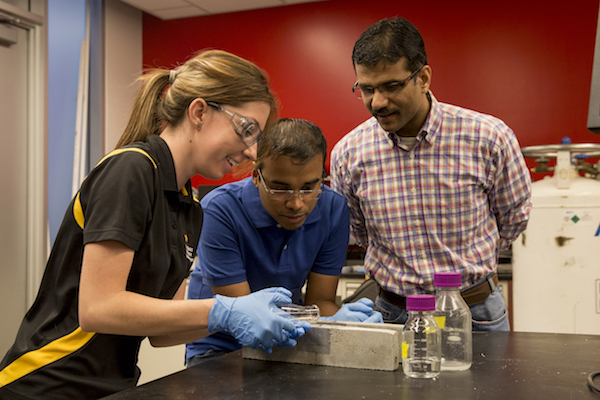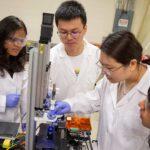
Neithalath cementing his status as pioneering civil engineering researcher

Above: Professor Narayanan Neithalath (at right) directs undergraduate engineering student Hannah Hansen (left) and Assistant Research Professor Sumanta Das in testing new techniques to heal cracks in concrete. Neithalath is being recognized by the American Society of Civil Engineers for his research on advanced materials for civil engineering applications. Photographer: Jessica Hochreiter/ASU
Narayanan Neithalath’s strides in research to improve the design and development of sustainable infrastructure and construction materials have been earning international attention in his field.
The latest recognition for the professor in the Ira A. Fulton Schools of Engineering at Arizona State University comes from the American Society of Civil Engineers (ASCE), which has awarded him a Walter L. Huber Civil Engineering Research Prize.
Neithalath is making particular progress with new materials and methods for producing more durable cement and concrete. But his efforts span across a wide range of the physical, chemical and mechanical aspects of these materials, as well as the environmental impacts of their production and use over their lifespans.
He is “one of the rising stars in the emerging areas of new and novel civil engineering materials, contributing greatly to the body of knowledge in this area,” says Professor G. Edward Gibson Jr., director of the School of Sustainable Engineering and the Built Environment in the Fulton Schools.
Gibson and Fulton Schools ASU Regents’ Professor Edward Kavazanjian point to Neithalath’s work to better understand the microstructures and properties of the materials as a fundamental step to developing stronger cement and more resilient concrete, and to designing more effective performance testing of the building materials.
Beyond that, they note Neithalath’s efforts to make cementless binding systems that could replace conventional Portland cement in many applications and thus significantly reduce the environmentally harmful greenhouse gas emissions produced by standard cement.
They also highlight Neithalath’s collaboration with industry to put his research findings into practice and his outstanding performance as a teacher of civil, environmental and sustainable engineering and as a mentor to students.
Other colleagues who nominated him for the Huber Prize described his work as creative, pioneering and potentially groundbreaking.
His research accomplishments have attracted funding from the U.S. Department of Energy, the Department of Transportation and the National Science Foundation (NSF), in addition to support from industry.
In 2008, he won an NSF CAREER Award, which is given to young scientists and engineers who demonstrate the potential to become research and education leaders in fields considered important to national interests.
Neithalath also won the Indian American Cultural Center award for outstanding accomplishments in sustainable engineering, developed and patented novel materials — including carbonated metallic binders, high-volume cement replacement systems and methods for crack control in concretes — and has more than 100 publications in peer-reviewed journals.
Last year, he led a multi-university research team whose proposal was one of 10 from among about 100 submissions selected for funding from the European Commission’s Infravation program, which aims to make breakthroughs in sustainable transportation technologies and infrastructure.
His team’s $1.6 million Infravation project involves developing long-lasting, fracture-resistant pavements for roads and bridges. Read more about the project.
Neithalath will be officially presented the Huber Prize in Portland, Oregon in September as part of the ASCE’s annual conference. The organization represents more than 150,000 members of the civil engineering profession in 177 countries.
Media Contact
Joe Kullman, [email protected]
480-965-8122
Ira A. Fulton Schools of Engineering



































